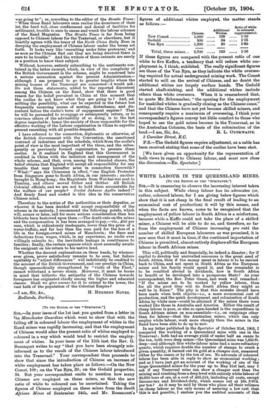SIR,—It is reassuring to observe the increasing interest taken in
this subject. While cheap labour has its advocates (or, rather, coloured labour, for I am giving below figures which show that it is not cheap in the final result of leading to an economical cost of production) it will by this means, and when the facts are known, come to be recognised that the employment of yellow labour in South Africa is a misfortune, because while a Kaffir could not take the place of a skilled miner, a Chinese will be able to do so, and therefore, so far from the employment of Chinese increasing pro rata the number of skilled European labourers as was promised, it is now seen that it must in time, if the continued importation of Chinese is permitted, almost entirely displace all the European labour in South African mines.
This will, politically and financially, be indeed a disaster ; for if capital to develop her unrivalled resources is the great need of South Africa, then if the money spent in labour is to be carried back to China, and not spent in South Africa as the European miner and his family would spend it, and the remainder is to be remitted abroad in dividends, how is South Africa to benefit or be developed into a prosperous State ? As your correspondent, the Rev. Peter Green, last week well remarked : " If the mines are to be worked by yellow labour, then for all the good they will do South Africa they might as well be in Essex." The pity is that this mistake should have been made when both objects—i.e., a more economical cost of production, and the quick development and colonisation of South Africa, by white men—could be attained if the mines there were worked like those in Australia and America. Either the result of cheap labour is poor, or else so open-handed is the expenditure in South African mines on non-essentials—i.e., on outgoings other than for labour—that the Australian mines, which can only employ white labour, work more cheaply than the mines in the Rand have been able to do up to now.
In my letter published in the Spectator of October 31st, 1903, I compared the working of a Queensland mine with one in the Transvaal ; both had an average yield of under half an ounce to the ton, both were deep mines—the Queensland mine was 1,650 ft. deep—and although this white-labour mine had a more refractory quartz, which requires double the number of stamps to crush a given quantity, it turned out its gold at a cheaper cost, measured either by the ounce or by the ton of ore. No advocate of coloured labour has been able in reply to show as economical working ; and as I have just got an account of the working of one of the large Queensland mines for the year up to May 31st last, may I ask if any Transvaal mine can show a cheaper cost than the mining and crushing from a deep level with entirely white labour of 80,850 tons of ore, at a cost of 465,518, including all costs, except Income-tax and Dividend-duty, which comes out at 16s. 3.97d. per ton ? As it may be said by those who place all their reliance on cheap labour as the only means of assuring a low cost that this is not possible, I enclose you the audited accounts of this
Can any of your readers show me a Company in South Africa which can exhibit as economical working as this with coloured labour? Can any of them work at a cost of even 20s. per ton of ore ? What the Transvaal requires—and it does require this—is to have cheaper railway freights from Durban, when wheat and flour, which can be landed there from North and South America as cheaply as in Liverpool, would, with the simple provision of large co-operative bakeries, enable bread to be sold at, say, 21d. for the half-quartern loaf, or even as cheaply as in the East End of London.
What is required, indeed, is cheap food and cheap houses for European miners, when they will compete successfully, as is shown above, with coloured labour. If the Government had helped in the way of guaranteeing a loan to provide houses for fifty thousand miners, then they would have done much to bring about an era of prosperity in South Africa.
am, Sir, &c., R. H.
" FORSAN ET HAEC



















































 Previous page
Previous page